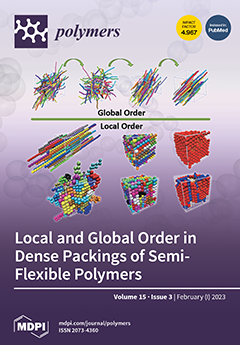This work aimed to use the electrospinning technique to obtain PBAT/PLA polymer fibers, with the semiconductors rutile titanium dioxide (TiO
2-R) and magnetite iron oxide (Fe
3O
4), in order to promote the photocatalytic degradation of environmental contaminants. The parameters
[...] Read more.
This work aimed to use the electrospinning technique to obtain PBAT/PLA polymer fibers, with the semiconductors rutile titanium dioxide (TiO
2-R) and magnetite iron oxide (Fe
3O
4), in order to promote the photocatalytic degradation of environmental contaminants. The parameters used in the electrospinning process to obtain the fibers were distance from the needle to the collecting target of 12 cm, flow of 1 mL h
−1 and voltage of 14 kV. The best mass ratio of semiconductors in the polymeric fiber was defined from a 2
2 experimental design, and the values obtained were 10% TiO
2-R, 1% Fe
3O
4 at pH 7.0. Polymer fibers were characterized by Scanning Electron Microscopy (SEM), Differential Scanning Calorimetry (DSC), X-ray Diffraction (XRD), Thermogravimetric Analysis (TGA) and Fourier Transform Infrared (FTIR) techniques. SEM measurements indicated a reduction in fiber diameter after the incorporation of semiconductors; for the PBAT/PLA fiber, the average diameter was 0.9466 ± 0.2490 µm, and for the fiber with TiO
2-R and Fe
3O
4 was 0.6706 ± 0.1447 µm. In the DSC, DRX, TGA and FTIR analyses, it was possible to identify the presence of TiO
2-R and Fe
3O
4 in the fibers, as well as their interactions with polymers, demonstrating changes in the crystallinity and degradation temperature of the material. These fibers were tested against Reactive Red 195 dye, showing an efficiency of 64.0% within 24 h, showing promise for photocatalytic degradation of environmental contaminants.
Full article






